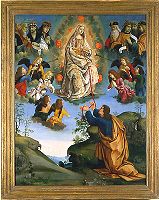 click to enlarge |
ASSUMPTION OF THE VIRGIN WITH SAINT THOMASMaster of the Lathrop Tondo SN 19, oil on panel From: "The Pages"
|
ARTIST:
This anonymous painter was first named by Berenson in 1906 for the Lathrop Tondo in the Paul Getty Museum.
Later Ragghianti renamed him as the Guinigi Painter from Lucca, having identified the left-hand coat of arms in the same tondo as that of the powerful Lucchese family. Ragghianti believed the artist was influenced by the Bolognese painter Amico Aspertini who was active in Lucca c.1506-1508/9.
Later still, Fahy proposed that the artist could be identified as Antonio Corsi, registered as a Lucchese painter in 1494.
SUBJECT / CONTEXT:
A Christian legend tells that St Thomas wanted proof of the Virgin’s Assumption, the term used to denote the taking up to Heaven of the soul and body of the Virgin Mary, three days after her death. The Virgin lowered her belt (cintola) to prove to “doubting Thomas” that her body had been transported to Heaven to join her soul after death. The legend continues with the story of a crusader from Prato (a town near Florence), who returned from a crusade to the Holy Land with the belt which had been given as a dowry to his wife, the daughter of a Greek priest in Jerusalem. The belt was deposited in the Cappella della Sacratissima Cintola at Prato, which accounts for the popularity of this subject in Florentine painting.
St Thomas was one of Christ’s apostles; he was also called “doubting Thomas” because he refused to believe in the Resurrection of Christ until convinced by sight and touch. In tradition he had a similar role, doubting the Assumption of the Virgin. He is shown here kneeling and accepting the Virgin’s belt as proof of Her Assumption.
PAINTING:
In Renaissance and later painting, the Assumption was portrayed in two or three elements, one above the other. The Virgin is in mid-air, standing or enthroned, being carried to Heaven by angels who sometimes play musical instruments. She may be surrounded by a halo, referred to as a mandorla (an almond-shaped frame enclosing the figure). The mandorla is the light that emanates from the divine being, and there may be a grouping of angels included within the mandorla’s framework.
Below the Virgin, on the ground, may be a group of saints – “doubting” Thomas being included because of his doubt of Her Assumption. The saints who can be identified in the upper part of this painting are:
In the oriental headdresses: St Dionysius, St Timothy, and St Hierotheus.
Bareheaded: St James and St Paul
According to Tomory, the other saints remain unidentified. Another source suggests these saints may be St. Epiphanius, Bishop of Cypress and contemporary of Timothy; St. Gregory ; and St. Sardis. All three historically defended the doctrine of the Assumption of Mary.
Additional Bibliography:
James Hill, Dictionary of Subjects and Symbols in Art, Harper & Row Publishers, New York, 1974
George Ferguson, Signs and Symbols in Christian Art, Oxford University Press, London, 1954
Museum Label:
Artist: Master of the Lathrop Tondo
active ca. 1490-1520, active in Florence and Lucca
Title: Assumption of the Virgin with St. Thomas (Madonna della Cintola)
Date: last quarter of the 15th Century
Medium: Oil and tempra on wood panel
Dimensions: 67 1/2 x 53 1/8 in. (171.5 x 134.9 cm)
Credit Line: Bequest of John Ringling, 1936
Object Number: SN19